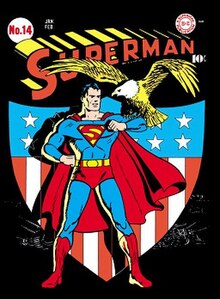Fred Ray
| Fred Ray | |
|---|---|
| Born | Frederic E. Ray, Jr. February 4, 1920[1] Harrisburg, Pennsylvania, U.S. |
| Died | January 23, 2001 (aged 80) |
| Area(s) | Penciller, Inker |
Notable works | Superman |
Frederic E. "Fred" Ray, Jr. (February 4, 1920 – January 23, 2001)
Biography
Early career

Fred Ray was born in
At 20, he broke into National Comics, the future
Ray debuted as the

Ray also drew occasional Batman covers for Detective Comics and Batman, and various heroes for covers of the anthology titles Star Spangled Comics and World's Finest Comics.[7]
Ray wrote and drew the
Later career
Ray continued drawing Tomahawk tales for more than two decades, through at least Tomahawk #119 (Dec. 1968), with incidental work appearing in some issues afterward. In 1969, he also began drawing and occasionally scripting anthological
Ray, an authority on military uniforms of the Revolutionary War and a consultant to the
References
- ^ "United States Social Security Death Index," index, FamilySearch (https://familysearch.org/pal:/MM9.1.1/JRHC-CYW : accessed 02 Mar 2013), Frederic E Ray, 23 January 2001.
- ^ Social Security Number 204-03-7262, at Social Security Death Index.
- ^ a b c "Frederick [sic] E. Ray, Jr. (1920 - 2001)". AskART: The Artists' Bluebook. Archived from the original on September 3, 2011. Source gives birthplace and "Jr."
- ISBN 9781793637130. Retrieved 23 January 2022.
- ^ Packer, Sharon (2010). Superheroes and Superegos: Analyzing the Minds Behind the Masks. ABC-CLIO. Retrieved 23 January 2022.
- ^ a b c Shaw, Scott (September 3, 2007). "Tomahawk No. 70". Scott Shaw!'s "Oddball Comics (column) #1175. Archived from the original on October 13, 2007.
- ^ a b c d e Fred Ray at the Grand Comics Database
- Lambiek Comiclopedia. Note: gives incorrect birth date. Archivedfrom the original on July 12, 2012.
- ^ a b c Hughes, Bob (January 24, 2009). "Who Drew Superman in the War Years?". SupermanArtists.Comics.org. Archived from the original on May 14, 2011. Retrieved November 19, 2007.
External links
- Fred Ray at the Comic Book DB (archived from the original)
